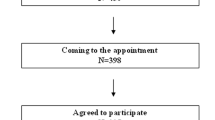Abstract
An algorithm has been proposed for the detection of white coat hypertension among subjects with elevated blood pressure (BP) on at least three clinic visits using home BP monitoring (screening test) and, if this is low, ambulatory BP monitoring (diagnostic test). This study aims to test this strategy in practice. The proposed algorithm was applied in 133 untreated subjects with elevated BP assessed in a previous prospective study using repeated clinic, home and ambulatory BP measurements. The proportions of detected and missed cases of white coat hypertension and the diagnostic value of the algorithm were calculated. By applying the algorithm, 99 subjects (74%) were found eligible for home measurements and 35 (26%) for ambulatory monitoring. There were 38 subjects with white coat hypertension (38%), of whom 15 (39%) were not detected by the proposed strategy. The sensitivity, specificity, and the positive and negative predictive value of the algorithm to diagnose white coat hypertension were 61, 81, 66 and 77%, respectively. Of the 34 subjects with normal BP on the third clinic visit, 15 (42%) had elevated home and/or ambulatory BP. These data suggest that, using the proposed strategy, many white coat hypertensives may remain undetected and may receive unnecessary long-term drug treatment. Therefore, more research is needed on the optimal strategy for detecting white coat hypertension in clinical practice.
This is a preview of subscription content, access via your institution
Access options
Subscribe to this journal
Receive 12 digital issues and online access to articles
$119.00 per year
only $9.92 per issue
Buy this article
- Purchase on Springer Link
- Instant access to full article PDF
Prices may be subject to local taxes which are calculated during checkout


Similar content being viewed by others
References
1999 World Health Organization—International Society of Hypertension guidelines for the management of hypertension. J Hypertens 1999; 17: 151–183.
Joint National Committee on Detection, Evaluation and Treatment of High Blood Pressure. The sixth report of the Joint National Committee on the detection, evaluation and treatment of high blood pressure (JNC VI). Arch Intern Med 1997; 24: 2413–2446.
Ramsay LE et al. Guidelines for management of hypertension: report of the third working party of the British Hypertension Society. J Hum Hypertens 1999; 13: 569–592.
Pickering T, for an American Society of Hypertension Ad Hoc Panel. Recommendations for the use of home (self) and ambulatory blood pressure monitoring. Am J Hypertens 1995; 9: 1–11.
Pickering TG . Self-monitoring of blood pressure. In: Ambulatory Monitoring and Blood Pressure Variability (Part 1). Science Press: London, 1990, p 8.5.
Asmar R, Zanchetti A, on behalf of the Organizing Committee and Participants. Guidelines for the use of self-blood pressure monitoring First International Consensus. J Hypertens 2000; 18: 493–508.
Stergiou GS et al. Diagnosis of hypertension using home or ambulatory blood pressure monitoring: comparison with the conventional strategy based on repeated clinic blood pressure measurements. J Hypertens 2000; 18: 1745–1751.
Stergiou GS, Zourbaki AS, Skeva II, Mountokalakis TD . White coat effect detected using self-monitoring of blood pressure at home: comparison with ambulatory blood pressure. Am J Hypertens 1998; 11: 820–827.
Denolle T et al. Self-measurement of blood pressure in clinical trials and therapeutical applications. Blood Press Monit 2000; 5: 145–149.
Centers for Medicare & Medicaid Services. Ambulatory Blood Pressure Monitoring (#CAG-00067N). Medicare Coverage Policy ∼ NCDs. Decision Memorandum. October 17, 2001. http://cms.hhs.gov/coverage/8b3-ff2.asp.
Feldman RD et al. 1999 Canadian recommendations for the management of hypertension. CMAJ 1999; 161(Suppl 12): S1--S22.
Staessen JA et al. Blood pressure measurement and cardiovascular outcome. Blood Press Monit 2001; 6: 355–370.
Den Hond E et al. Self-measured versus ambulatory blood pressure in the diagnosis of hypertension. J Hypertens 2003; 21: 717–722.
Nesbitt SD et al. Home blood pressure as a predictor of future blood pressure stability in borderline hypertension. The Tecumseh Study. Am J Hypertens 1997; 10: 1270–1280.
Altman DG . Diagnostic tests. In: Practical Statistics for Medical Research. Chapman & Hall: London 1991, pp 409–419.
Parati G, Stergiou G . Self measured and ambulatory blood pressure in assessing the white coat phenomenon. J Hypertens 2003; 21: 677–682.
O'Brien E et al. Use and interpretation of ambulatory blood pressure monitoring: recommendations of the British Hypertension Society. BMJ 2000; 320: 1128–1134.
Stergiou G et al. Reproducibility of clinic, ambulatory and home blood pressure: implications on the design of trials for the assessment of the efficacy of antihypertensive drugs. Am J Hypertens 2002; 15: 101–104.
Liu JE et al. Cardiac and arterial target organ damage in adults with elevated ambulatory and normal office blood pressure. Ann Intern Med 1999; 131: 564–572.
Bobrie G et al. Is ‘isolated home’ hypertension as opposed to ‘isolated office’ hypertension a sign of greater cardiovascular risk? Arch Intern Med 2001; 161: 2205–2211.
Author information
Authors and Affiliations
Corresponding author
Additional information
This paper has been presented at the 13th Meeting of the European Society of Hypertension, Milan, June 2003.
Rights and permissions
About this article
Cite this article
Stergiou, G., Alamara, C., Skeva, I. et al. Diagnostic value of strategy for the detection of white coat hypertension based on ambulatory and home blood pressure monitoring. J Hum Hypertens 18, 85–89 (2004). https://doi.org/10.1038/sj.jhh.1001640
Received:
Revised:
Accepted:
Published:
Issue Date:
DOI: https://doi.org/10.1038/sj.jhh.1001640
Keywords
This article is cited by
-
Home Blood Pressure Monitoring in the Diagnosis and Treatment of Hypertension: A Systematic Review
American Journal of Hypertension (2011)
-
Role of ambulatory and home blood pressure recording in clinical practice
Current Cardiology Reports (2009)
-
Detecting white coat and reverse white coat effects in clinic settings using measures of blood pressure habituation in the clinic and patient self-monitoring of blood pressure
Journal of Human Hypertension (2007)
-
Towards improving the clinical assessment and management of human hypertension: an overview from this Journal
Journal of Human Hypertension (2006)



